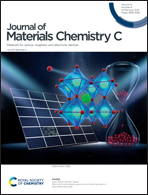Fully-physically crosslinked silk fibroin/poly(hydroxyethyl acrylamide) hydrogel with high transparency and adhesive properties for wireless sensing and low-temperature strain sensing†
Abstract
Hydrogel-based flexible electronics, especially stretchable human motion sensors, have been intensely investigated in the past few decades. However, challenges remain in the preparation of anti-freezing hydrogels with balanced properties of high sensitivity, large sensing range and suitable mechanical properties in a broad temperature range. In this study, we fabricate a fully-physically crosslinked poly(hydroxyethyl acrylamide)/silk fibroin-LiCl (PHEAA/SF-LiCl) hydrogel with excellent mechanical properties at both room temperature and subzero temperature. Strain sensitivity and durability at both room temperature (25 °C) and low temperature (−30 °C) have been characterized. Strain sensors which can monitor human movements in different situations, including wireless sensing and low temperature sensing have been fabricated, indicating their huge potential in flexible electronics, remote health control and electronic skins.



 Please wait while we load your content...
Please wait while we load your content...